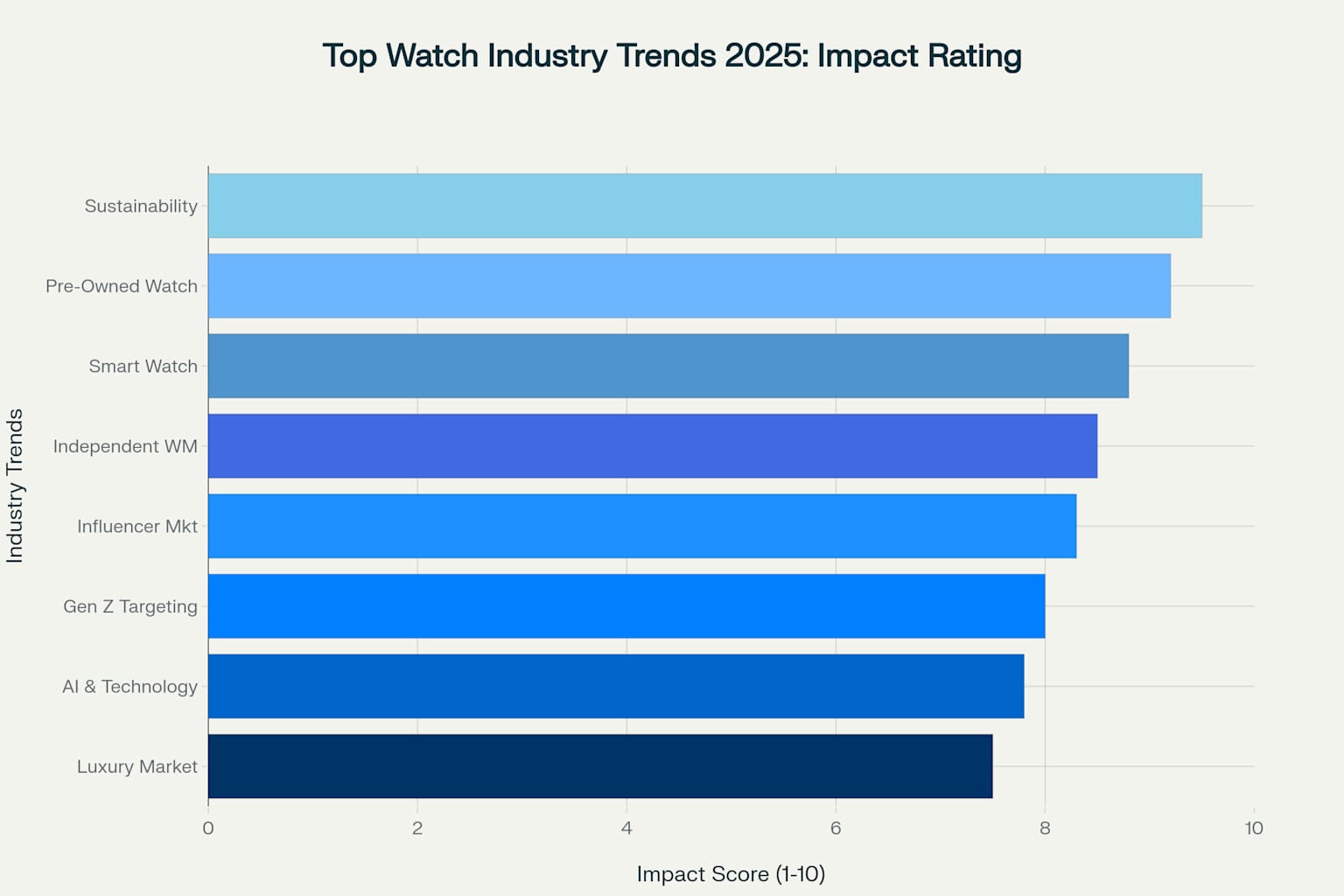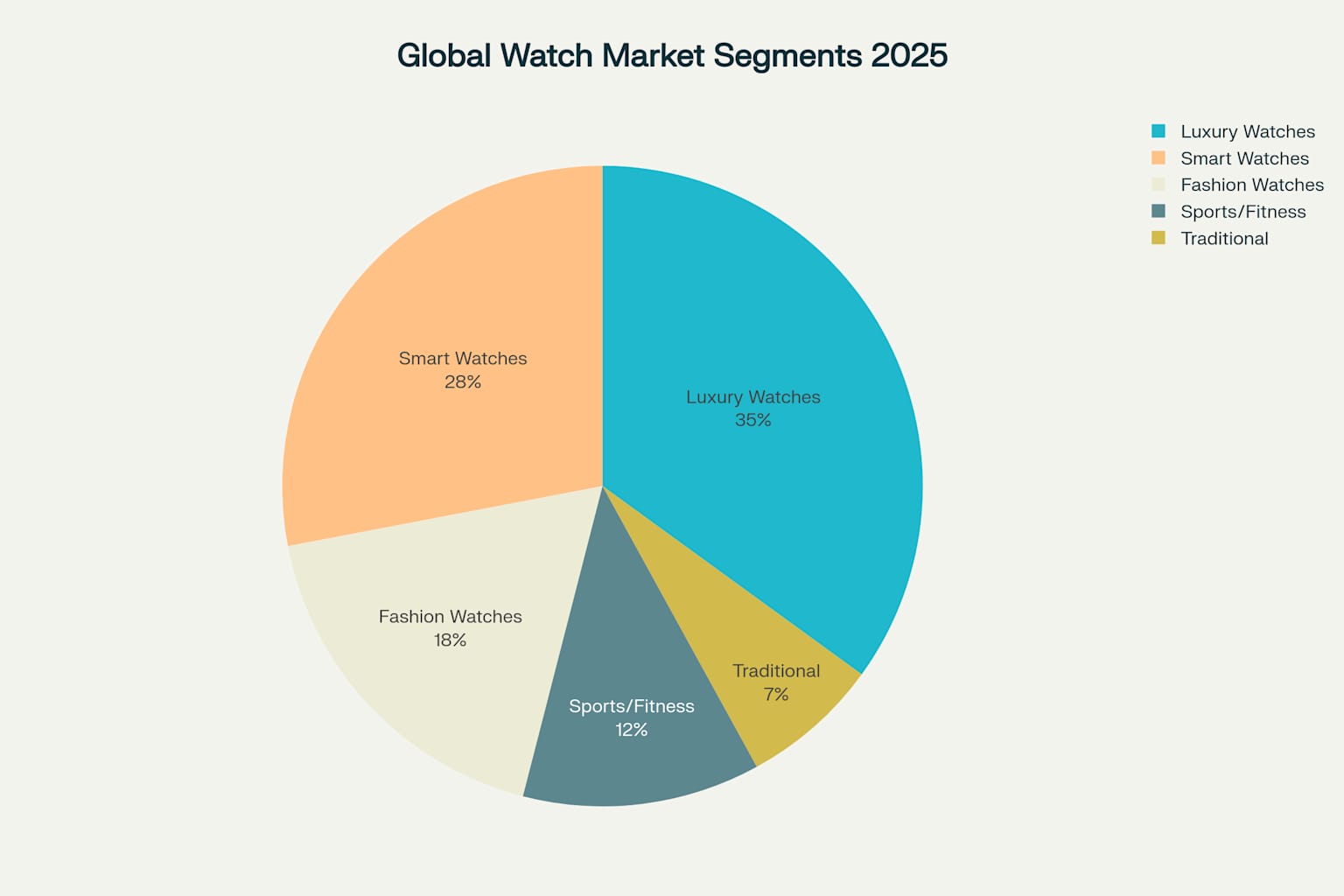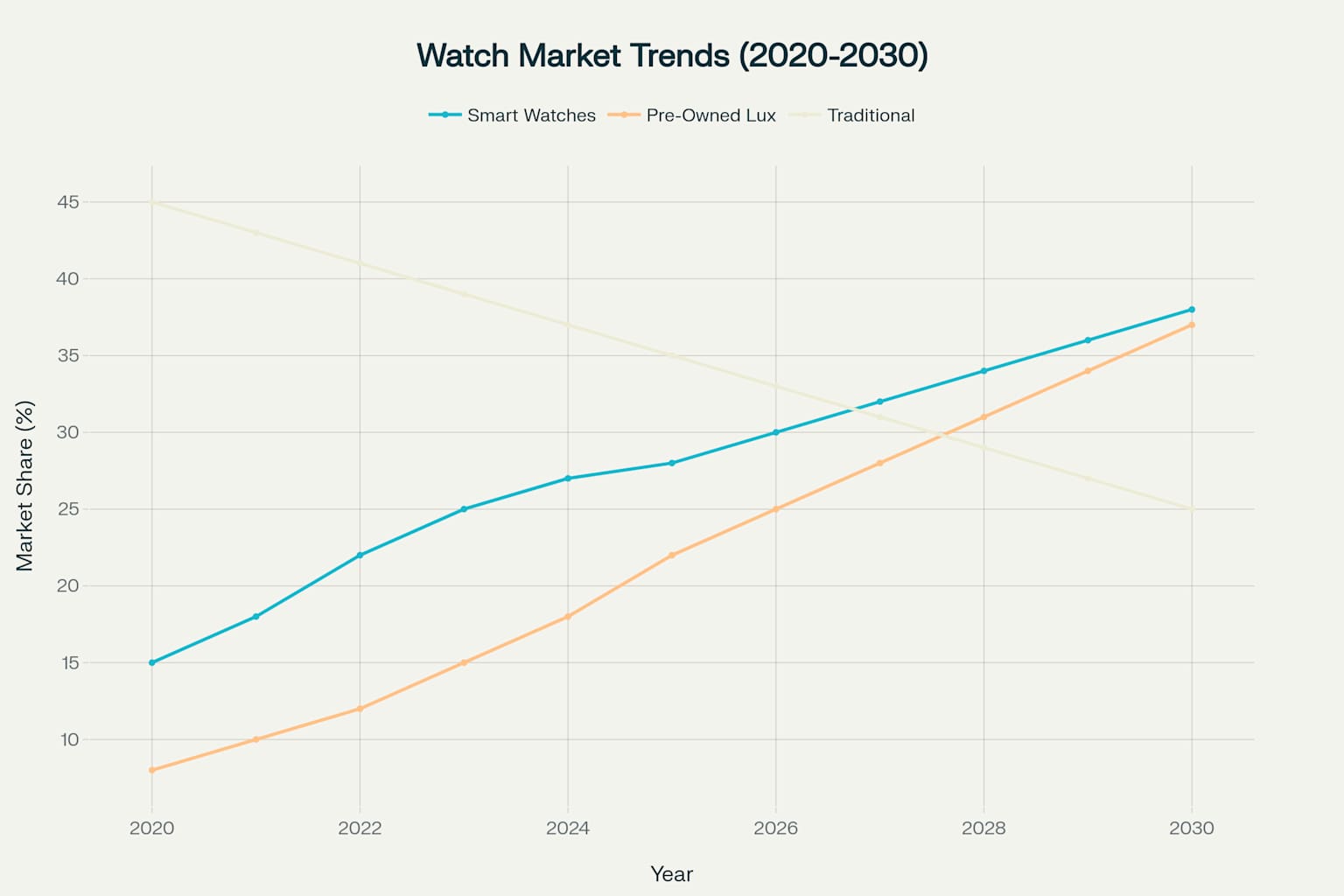
The Watch Industry in 2025: Market Trends, Challenges, and Opportunities Reshaping Timepiece Culture
The global watch industry is experiencing its most significant transformation in decades, with traditional luxury brands facing unprecedented challenges while new market segments emerge with explosive growth. As we progress through 2025, the industry finds itself at a crossroads where heritage craftsmanship meets cutting-edge technology, and where sustainability concerns are reshaping consumer preferences across all price segments.
Recent data reveals a complex landscape where Swiss watch exports have declined by 7.9% globally, yet specific markets like the United States show remarkable resilience with 13.7% growth, while Asian markets face significant contractions. This divergence highlights the industry's need to adapt to rapidly changing consumer behaviors and economic conditions worldwide.

Current Market Landscape and Performance
Swiss Watch Export Challenges
The Swiss watch industry, long considered the gold standard of luxury timepieces, faces mounting pressure in 2025. Export data shows concerning trends, with Hong Kong experiencing an 18.8% decline and China showing a dramatic 27.0% drop in Swiss watch imports. These figures reflect broader economic uncertainties and shifting consumer preferences in key Asian markets.
However, the picture isn't uniformly negative. The United States market demonstrates strong performance with significant growth, while emerging markets like India show impressive 59.7% increases, suggesting opportunities for diversification beyond traditional strongholds.
Market Segmentation and Growth Patterns
The watch industry's evolution is best understood through its changing market segments, each responding differently to current economic and cultural pressures.

Luxury watches continue to dominate market value despite volume challenges, with prices above CHF 3,000 showing resilience even as mid-tier segments struggle. This trend suggests a polarization where consumers either invest in high-end pieces or opt for more affordable alternatives, leaving the middle market particularly vulnerable.
The Rise of Pre-Owned Luxury Watches
One of 2025's most significant trends is the explosive growth of the pre-owned luxury watch market, valued at $24.38 billion in 2023 and projected to reach $49.11 billion by 2032. This growth is driven by multiple factors including affordability concerns, sustainability consciousness, and improved authentication processes.
Celebrity influences and brand-backed certified pre-owned programs from manufacturers like Rolex, Omega, and Cartier have legitimized the secondary market. The trend reflects broader consumer shifts toward circular economy principles and value-conscious purchasing decisions.

Technology Integration and Smart Watch Competition
The Smartwatch Challenge
The smartwatch sector continues to reshape industry dynamics, though not without its own challenges. Apple Watch sales have declined from 43 million units in 2022 to 34 million in 2024, with market share eroding to 22.5%.However, Chinese brands like Huawei and Xiaomi are gaining ground, capturing 16% and 10% of the global market respectively.
Traditional watch manufacturers face the complex challenge of integrating smart technology without compromising their brand heritage. Movado Group's recent statement that they are "not currently manufacturing new smart watch models" reflects the difficulties many established brands face in this segment.
AI and Manufacturing Innovation
Artificial intelligence is increasingly transforming watch manufacturing and customer experience. Zepp Health Corp's integration of AI in their smartwatch operating systems, including features like Zepp Flow powered by large language models, demonstrates how technology companies are pushing boundaries.
Traditional manufacturers are exploring AI applications in quality control, with brands implementing AI-controlled quality-checking mechanisms to spot microscopic flaws and ensure consistent standards. This technological integration represents a necessary evolution for maintaining competitiveness in an increasingly automated market.
Sustainability and Environmental Consciousness
Eco-Friendly Material Innovation
Sustainability has emerged as a defining trend for 2025, with 86% of brands considering certified ethical gold important and 76% prioritizing recycled materials. Consumer preferences align with this shift, as 34% would choose a brand committed to sustainability over traditional image-focused marketing.
Leading manufacturers are implementing comprehensive sustainability initiatives. IWC, Panerai, and Cartier are increasingly using recycled materials and environmentally friendly production processes, with cases made from recycled titanium and straps from vegan alternatives like pineapple leather becoming commonplace.
Circular Economy Adoption
The Watch and Jewellery Initiative 2030 has made significant progress in promoting sustainability across the industry.Their 2024/2025 report highlights achievements in climate resilience, resource preservation, and inclusiveness, with 50 member companies signing the Women's Empowerment Principles.
This focus on circular economy principles extends beyond materials to encompass entire business models, with pre-owned watch platforms promoting sustainability by reusing consumer products and extending product lifecycles.
Generational Shifts and Marketing Evolution
Targeting Younger Demographics
Generation Z and millennials are reshaping watch industry priorities, with these demographics expected to represent 75% of luxury buyers by 2026. Their preferences for resale, rental, and authentic brand experiences are forcing traditional marketing approaches to evolve.
Social media platforms have become crucial battlegrounds for brand engagement. The influencer marketing industry, valued at $20.24 billion in 2024 and projected to reach $71.04 billion by 2032, represents a significant opportunity for watch brands.
Celebrity and Influencer Impact
High-profile endorsements continue to drive market trends, with celebrities like Kanye West wearing vintage Cartier Crash watches creating significant market interest. Mark Zuckerberg's recent adoption of luxury watches, including a vintage Rolex Daytona "Paul Newman," signals a shift in Silicon Valley culture that previously avoided traditional timepieces.
The rise of micro and nano-influencers offers brands more targeted, authentic connections with niche communities.These smaller-scale partnerships often achieve higher engagement rates and stronger trust than traditional celebrity endorsements.
Independent Watchmaking Renaissance
Artisanal Revival
The independent watchmaking sector is experiencing renewed interest as collectors seek unique, limited-production pieces. Brands like F.P. Journe, Laurent Ferrier, and Kari Voutilainen are commanding premium prices due to their extremely limited production and artisanal approach.
This trend reflects broader consumer desires for authenticity and craftsmanship over mass production. Independent watchmakers producing fewer than 50 watches annually create exclusivity that resonates with discerning collectors seeking alternatives to mainstream luxury brands.
Investment Potential
Independent watches are increasingly viewed as investment opportunities, with strong long-term appreciation potential due to their rarity and cult following. The Independent Watchmaking Report 2025 reveals that many independent brands not only survived post-pandemic market cooling but actually flourished.
Supply chain challenges that affect larger manufacturers often benefit independents, who can maintain more flexible, personalized relationships with suppliers and customers.
Regional Market Dynamics
US Market Strength
The United States continues to demonstrate resilience, showing 13.7% growth in March 2025 despite global uncertainties. However, this growth is partially artificial, driven by advance purchases ahead of potential 31% tariffs on Swiss imports.
US tariffs on Swiss goods pose significant challenges for 2025, with importers stockpiling inventory to avoid higher costs. This front-loading of purchases creates temporary spikes that mask underlying demand patterns.
Asian Market Pressures
China and Hong Kong face continued pressure, with exports declining 11.5% and 11.3% respectively in recent months.Economic downturns and declining stock markets indicate sustained challenges for luxury consumption in these previously robust markets.
Singapore also shows modest decreases, suggesting broader regional challenges beyond China's specific economic situation. These trends force brands to diversify their geographic strategies and reduce dependence on traditionally strong Asian markets.
Industry Challenges and Adaptations
Supply Chain and Manufacturing
The watch industry continues to grapple with supply chain complexities, particularly affecting independent manufacturers who lack the scale advantages of major brands. Component shortages and increased costs pressure margins across all segments.
Traditional manufacturers are investing in vertical integration and local sourcing to reduce dependencies. The consolidation trend, with industry insiders predicting inevitable mergers, reflects pressures to achieve operational efficiencies.
Retail Transformation
Physical retail faces ongoing challenges from e-commerce growth and changing consumer shopping patterns. Brands are investing heavily in omnichannel experiences that seamlessly integrate online and offline touchpoints.
The "wear, trade, repeat" mentality among modern collectors is changing traditional retail models. This fluid approach to collecting prioritizes experience over accumulation, requiring retailers to adapt their sales and service strategies.
Future Outlook and Strategic Implications
Technology Integration Imperatives
The watch industry must balance technological innovation with heritage preservation. Successful integration requires understanding that technology should enhance rather than replace traditional craftsmanship values.
AI applications in manufacturing, customer service, and personalization will become increasingly important for maintaining competitive advantages. However, brands must implement these technologies thoughtfully to avoid alienating traditional customers.
Sustainability as Competitive Advantage
Environmental consciousness will continue driving purchasing decisions, making sustainability initiatives not just ethical imperatives but business necessities. Brands that proactively address environmental concerns will capture growing market segments focused on responsible consumption.
The circular economy model, encompassing both pre-owned markets and sustainable manufacturing, represents a fundamental shift that successful brands must embrace.
Conclusion
The watch industry in 2025 stands at a pivotal moment where traditional excellence meets modern innovation.While established Swiss exports face headwinds, emerging segments like pre-owned luxury watches and sustainable timepieces show remarkable growth potential.
Success in this transformed landscape requires strategic agility, technological integration, and deep understanding of evolving consumer values. Brands that successfully balance heritage with innovation, sustainability with luxury, and global reach with local relevance will define the industry's next chapter.
The data clearly indicates that the watch industry's future lies not in choosing between tradition and innovation, but in thoughtfully combining both to create compelling value propositions for increasingly sophisticated consumers. As we progress through 2025, the most successful brands will be those that can navigate this complex landscape while staying true to the fundamental human desire for beautiful, meaningful timepieces.


Leave a comment